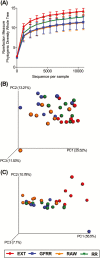Apparent total-tract macronutrient digestibility, serum chemistry, urinalysis, and fecal characteristics, metabolites and microbiota of adult dogs fed extruded, mildly cooked, and raw diets1
- PMID: 29893876
- PMCID: PMC6127788
- DOI: 10.1093/jas/sky235
Apparent total-tract macronutrient digestibility, serum chemistry, urinalysis, and fecal characteristics, metabolites and microbiota of adult dogs fed extruded, mildly cooked, and raw diets1
Abstract
Despite their popularity, little research has been performed on lightly cooked and raw diet formats for pets. Therefore, the objective of this study was to determine the apparent total-tract macronutrient digestibility (ATTD); fecal characteristics, metabolites, and microbiota; serum chemistry metabolites; urinalysis; and voluntary physical activity levels of adult dogs fed commercial diets differing in processing type. The diets included: 1) extruded dry kibble (EXT) diet; 2) high-moisture roasted refrigerated (RR) diet; 3) high-moisture grain-free roasted refrigerated (GFRR) diet; and 4) raw (RAW) diet. Eight dogs (mean age = 3.6; mean BW = 13.0 kg) were used in a replicated 4 × 4 Latin square design. Each period consisted of 28 d, with a 14-d adaptation phase followed by a 7-d phase for measuring voluntary physical activity, 1-d adaptation phase to metabolic cages, 5-d phase for fecal and urine collection, and 1 d for blood collection. Except for microbiota, all data were analyzed statistically by mixed models using SAS. Microbiota data were analyzed using Quantitative Insights Into Microbial Ecology (QIIME) and Statistical Analyses of Metagenomic Profiles (STAMP) software. Many differences in digestibility were observed, including greater (P < 0.05) ATTD of CP and fat in dogs fed GFRR and RR than dogs fed EXT. Dogs fed RAW had the lowest fecal pH and DM %, but fecal scores were not affected. Dogs fed RR had higher (P < 0.05) fecal indole and total phenol and indole concentrations than dogs fed the other diets. Dogs fed RAW had a higher (P < 0.05) fecal ammonia concentration than dogs fed the other diets. Fecal microbial diversity was altered by diet, with dogs fed GFRR and RAW having reduced species richness than dogs fed EXT. Dogs fed RR, GFRR, or RAW had lower (P < 0.05) Actinobacteria and higher (P < 0.05) Fusobacteria than dogs fed EXT. Dogs fed RAW or GFRR had higher (P < 0.05) Proteobacteria than dogs fed EXT or RR. Dogs fed RAW had higher (P < 0.05) Bacteroidetes and lower (P < 0.05) Firmicutes than dogs fed EXT. Serum triglycerides were within reference ranges, but greater (P < 0.05) in dogs fed EXT than dogs fed GFRR and RAW. All diets were well tolerated and dogs remained healthy throughout the study. In conclusion, the lightly cooked and raw diets tested were highly palatable, highly digestible, reduced blood triglycerides, maintained fecal quality and serum chemistry, and modified the fecal microbial community of healthy adult dogs.
Keywords: canine nutrition; diet processing; gastrointestinal microbiome; nutrient digestibility.
© The Author(s) 2018. Published by Oxford University Press on behalf of the American Society of Animal Science. All rights reserved. For permissions, please e-mail: journals.permissions@oup.com.
Figures



References
-
- AAFCO 2016. Official Publication. Association of American Feed Control Officials, Inc, Oxford, IN.
-
- Aldrich G. 2006. Rendered products in pet food. Essential rendering. All about the animal by-product industry. National Renderers Association, Arlington, VA: p. 159–177.
-
- American Association of Cereal Chemists (AACC) 1983. Approved methods. 8th ed Amer. Assoc. Cereal Chem, St Paul, MN.
-
- American Pet Products Association (APPA) 2017. Pet industry market size and ownership statistics. APPA, Greenwich, CT.
-
- Association of Official Analytical Chemists (AOAC) 2006. Official methods of analysis. 17th ed Assoc. Off. Anal. Chem, Gaithersburg, MD.
MeSH terms
Substances
LinkOut - more resources
Full Text Sources
Other Literature Sources
Miscellaneous

